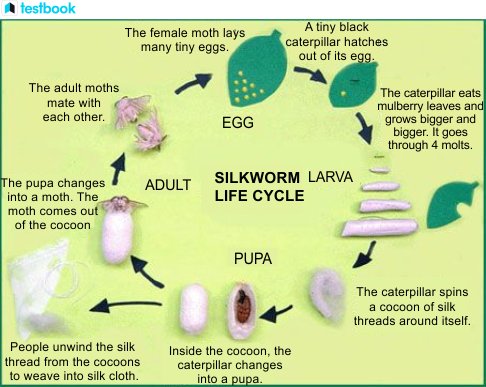
Silkworms are the larvae of the silk moth, *Bombyx mori*, and they’re known for producing silk—a material that’s been cherished for thousands of years. Each phase of their life is crucial, not just for their growth, but also for the silk-making process. So, grab a cup of coffee and let’s explore these stages together, diving into the visual charts that illustrate their transformations.
The Life Cycle of Silkworms
Silkworms undergo a complete metamorphosis, which means they experience distinct growth stages that look nothing like each other. As they develop, they go through four primary stages: **egg, larva (caterpillar), pupa (cocoon),** and **adult moth**. Each phase is essential for their growth and ultimately affects the quality of silk produced.
To visualize this, think of a silkworm’s life cycle as a four-part series. Each episode reveals a new character, with unique challenges and changes. The journey starts with tiny eggs, which hatch into voracious caterpillars, then they enter the cocoon stage, where magic happens before they finally emerge as adult moths.
Stage 1: The Egg Stage
The first stage of silkworm development is the **egg** stage. If you’re imagining miniature pearls, you’re spot on! These eggs are small, shiny, and usually laid in clusters. A single female moth can lay anywhere from 300 to 400 eggs.
This stage is brief, lasting around 10 days. The egg needs specific conditions to hatch, such as warmth and humidity. If the conditions are just right, these little eggs will start to hatch, and the silkworms will emerge. You might picture them as tiny, wriggling beings—almost like gummy worms!
Visual Chart: Egg Stage
| Timeframe: | 10 days |
| Appearance: | Small, shiny, oval-shaped |
| Key Factors: | Temperature, humidity, and light |
Stage 2: The Larva (Caterpillar) Stage
Once the eggs hatch, the silkworms enter the **larva**, or caterpillar, stage. This is when the fun really begins! For about 4 to 6 weeks, they eat voraciously—primarily munching on **mulberry leaves**. Honestly, they’re like little eating machines, growing rapidly and shedding their skin multiple times through a process called molting.
During this stage, the silkworms experience several instars, which means they go through a series of growth spurts. Each instar looks a bit different, growing larger and often changing color slightly. They can grow more than 100 times their original size, which is quite impressive!
Visual Chart: Larva Stage
| Duration: | 4 to 6 weeks |
| Appearance: | Green or yellow, segmented body |
| Key Factors: | Food supply, temperature, environment |
Stage 3: The Pupa (Cocoon) Stage
After getting their fill of leaves, the silkworms enter the **pupa**, or cocoon stage. This is one of the most fascinating phases of their life. They stop eating and start spinning silk around themselves, creating a protective cocoon. Imagine them wrapping themselves up like a snug burrito, made entirely of silk!
This stage lasts about 2 to 3 weeks, during which the silkworm undergoes incredible changes. Inside the cocoon, the magic of metamorphosis happens. The caterpillar cells break down and transform into an adult moth. It’s like a dramatic transformation scene in a movie!
Visual Chart: Pupa Stage
| Duration: | 2 to 3 weeks |
| Appearance: | Silken cocoon, usually creamy white |
| Key Factors: | Humidity, temperature, silk production |
Stage 4: The Adult Moth Stage
Finally, we reach the **adult moth** stage. After completing their transformation, the moths emerge from their cocoons, looking quite different from the caterpillars they once were. As adults, they are primarily focused on reproduction. Male silkworm moths are attracted to female moths by scent, and once they mate, the cycle begins again.
Interestingly, the adult moth has no mouthparts to eat. Their main purpose is to reproduce. After a short period, they’re done; their entire life cycle is about 6 to 8 weeks. It’s kind of a short life when you think about it!
Visual Chart: Adult Moth Stage
| Duration: | 1 week |
| Appearance: | White or yellow wings, larger body |
| Key Factors: | Mating, laying eggs |
Why Understanding Silkworm Development Matters
You might be wondering why all this matters. Well, understanding the **stages of silkworm development** not only highlights the complexity of their life cycle but also emphasizes the importance of silk farming. Knowing the right conditions for each stage can lead to higher quality silk production, which benefits both farmers and industries relying on silk.
Moreover, it showcases how interconnected nature can be. By understanding silkworm growth, we can learn about sustainability, agriculture, and the delicate balance of ecosystems. Each stage of the life cycle has its role, and when we take care of these creatures, we contribute to a larger environmental effort.
Final Thoughts
So, there you have it! The journey of a silkworm from egg to adult moth is a truly remarkable process filled with fascinating transformations. Each stage plays a vital role in not just their life but also in the world of silk production. By keeping these stages in mind, we can appreciate the beauty of nature’s cycles and the importance of caring for these tiny yet mighty creatures.
